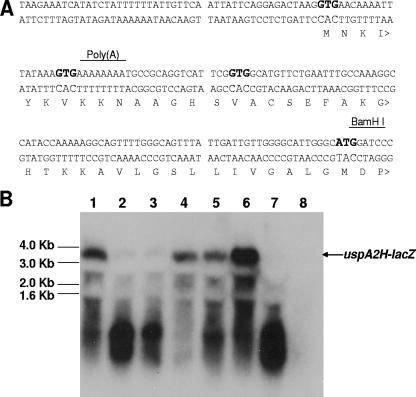FIG. 5.
Use of site-directed mutagenesis to identify the translation initiation codon of the O46E uspA2H ORF. (A) Nucleotide sequence of the distal portion of the uspA2H promoter region and the 5′ end of the uspA2H ORF. The four putative translation initiation sites (three GTG codons and one ATG codon) are indicated in bold. The BamHI site used for construction of the uspA2H-lacZ translational fusion in pAC7 is also indicated. (B) Northern blot analysis of uspA2H-lacZ transcription in E. coli XL10-Gold containing the following plasmids: lane 1, pWW105 [with a poly(A) tract containing eight A residues]; lane 2, pWW106 [with a poly(A) tract containing seven A residues]; lane 3, pWW105.1 with the first GTG changed to ACT; lane 4, pWW105.2 with the second GTG changed to ACT; lane 5, pWW105.3 with the third GTG changed to ACT; lane 6, pWW105.M with the ATG changed to ACT; lane 7, pWW106.M with the ATG changed to ACT; lane 8, pAC7 (negative control). The probe for Northern blot analysis was the uspA2H-specific, 32P-labeled oligonucleotide WW72 (Fig. 4A). DNA molecular size markers are indicated on the left side of panel B.

